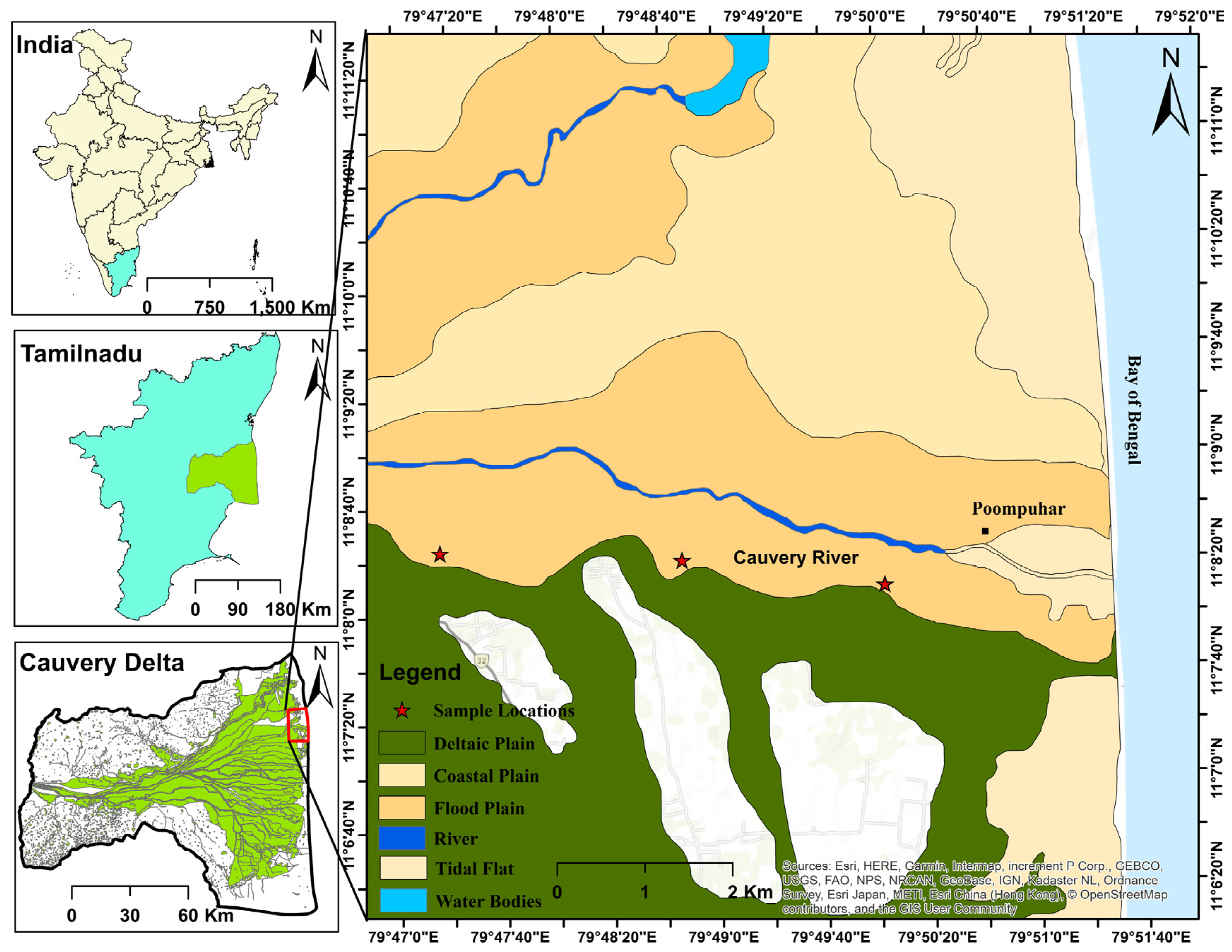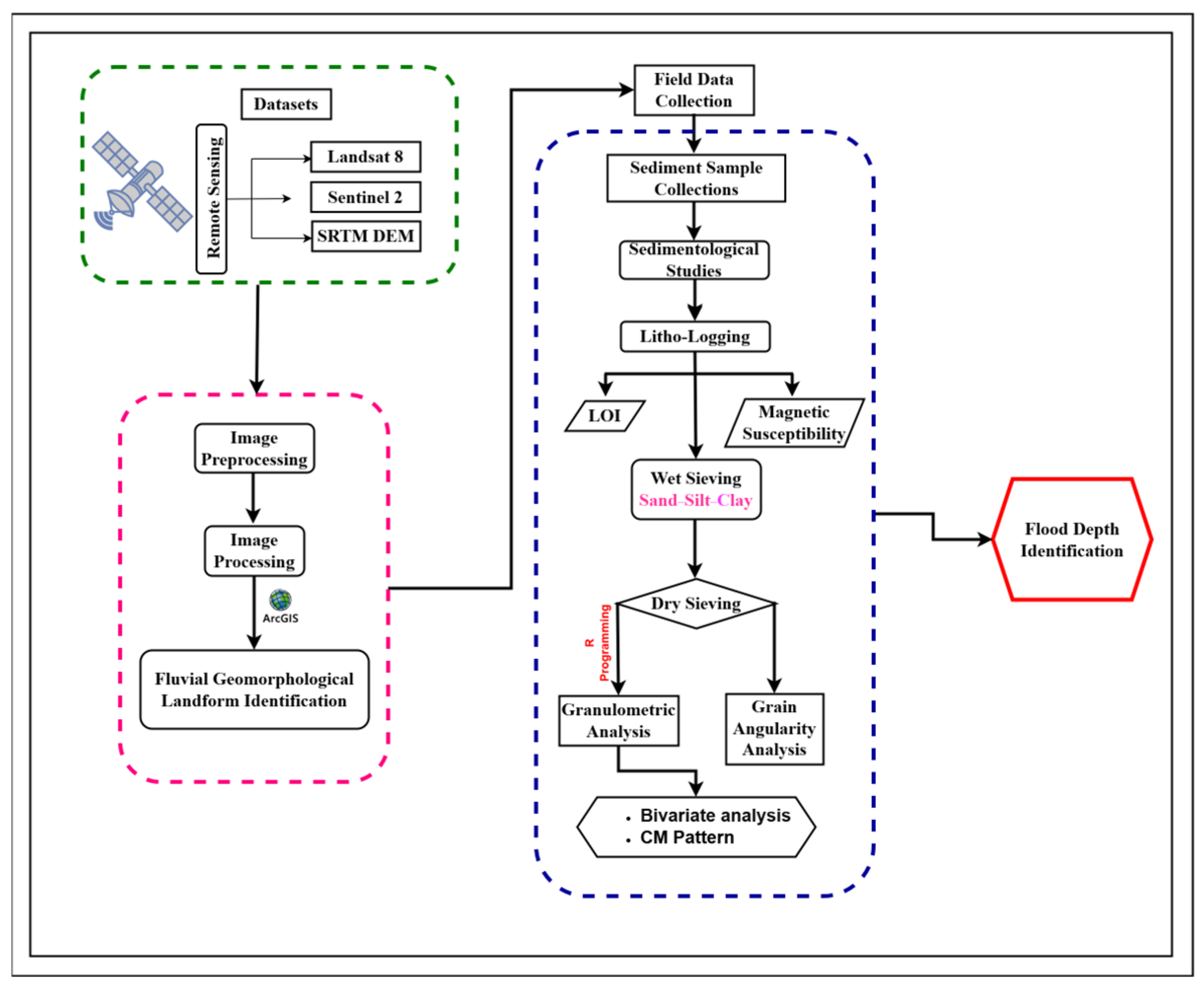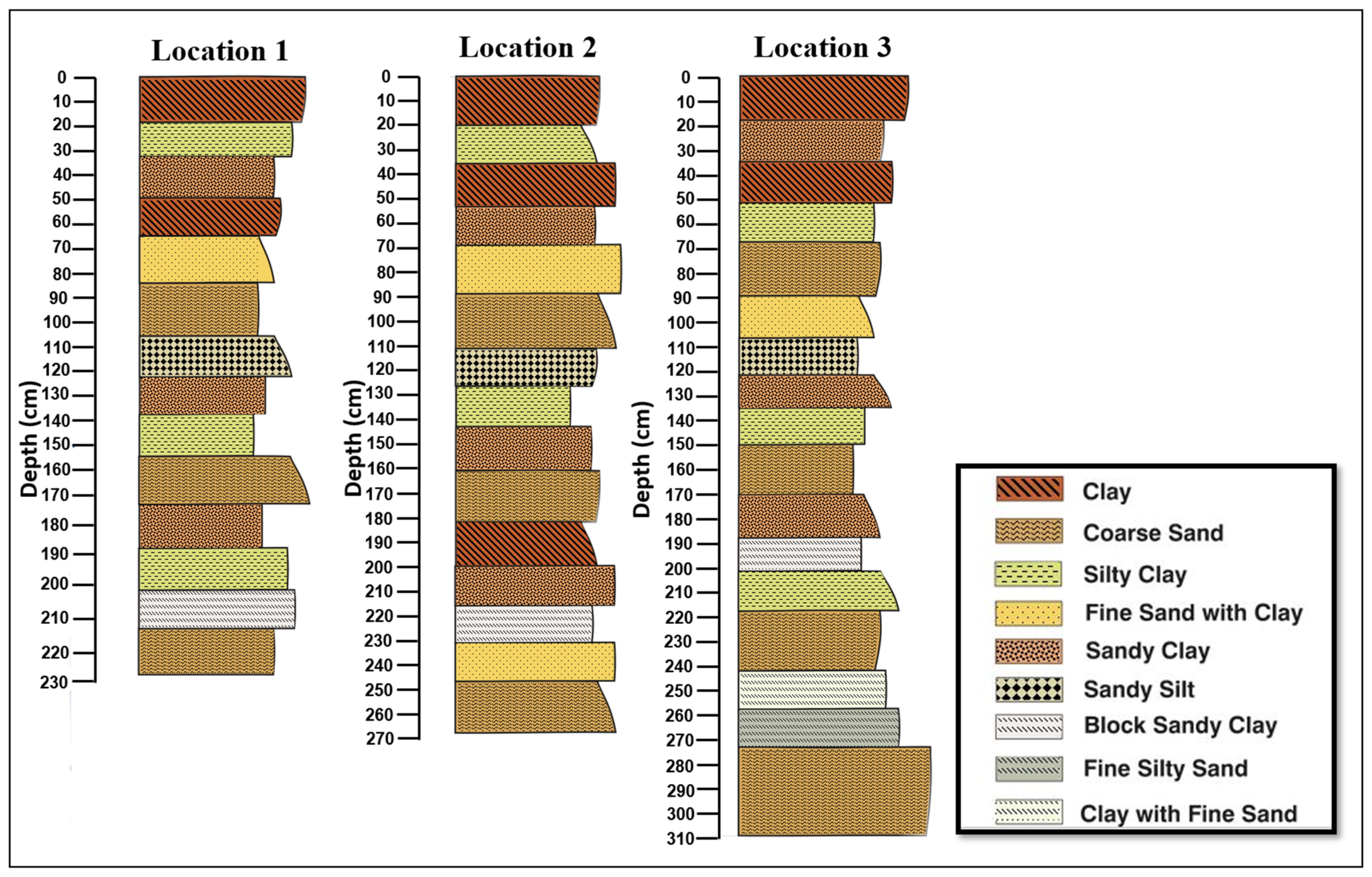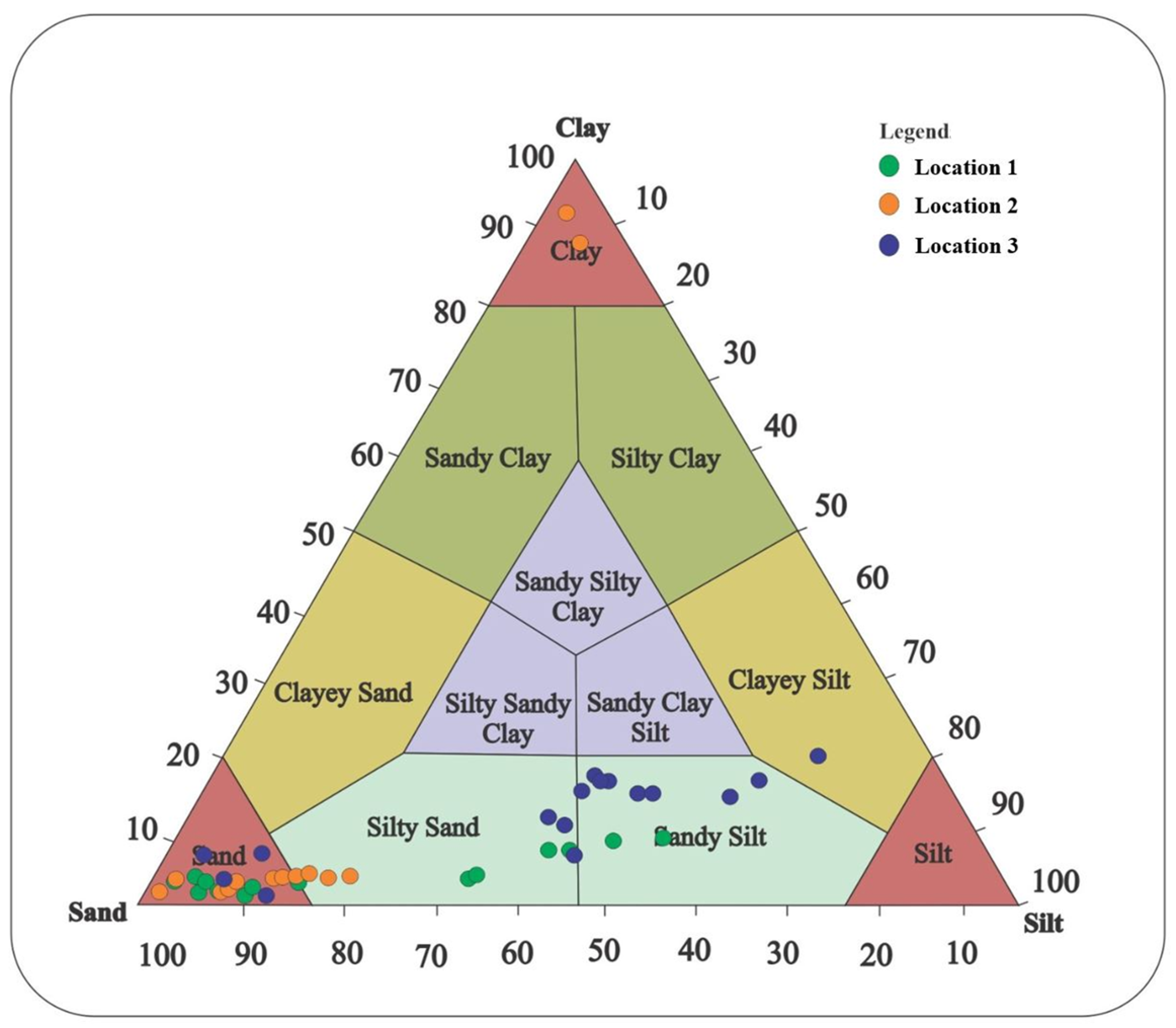Holocene Paleoflood Stratigraphy and Sedimentary Events in the Poompuhar Reach, Lower Cauvery River
Abstract
1. Introduction
2. Study Area
3. Methodology
4. Results
4.1. Location 1
4.1.1. Lithostratigraphy
4.1.2. Loss on Ignition
4.1.3. Magnetic Susceptibility
4.1.4. Sand–Silt–Clay
4.1.5. Granulometric Analyses
Bivariate Grain Size
CM Pattern
4.1.6. Angularity Study
4.2. Location 2
4.2.1. Lithostratigraphy
4.2.2. Loss on Ignition
4.2.3. Magnetic Susceptibility
4.2.4. Sand–Silt–Clay
4.2.5. Granulometric Analyses
Bivariate Grain Size
CM Pattern
4.2.6. Angularity Study
4.3. Location 3
4.3.1. Lithostratigraphy
4.3.2. Loss on Ignition
4.3.3. Magnetic Susceptibility
4.3.4. Sand–Silt–Clay
4.3.5. Granulometric Analyses
Bivariate Grain Size
CM Pattern
4.3.6. Angularity Study
4.4. Multi-Proxy Consistency: Quantifying Event-Bed Identification
5. Discussion
5.1. Fidelity of the Paleoflood Archive: Multi-Proxy Validation
5.2. Late Holocene Chronology and Regional Climate Synchronisation
5.3. Geomorphic Thresholds and the Fluvial Abandonment of Poompuhar
5.4. Geochronological Outlook: Addressing Methodological Limitations
6. Conclusions
Author Contributions
Funding
Data Availability Statement
Acknowledgments
Conflicts of Interest
References
- Wilhelm, B.; Amann, B.; Corella, J.P.; Rapuc, W.; Giguet-Covex, C.; Merz, B.; Støren, E. Reconstructing Paleoflood Occurrence and Magnitude from Lake Sediments. Quaternary 2022, 5, 9. [Google Scholar] [CrossRef]
- Benito, G.; Greenbaum, N.; Medialdea, A.; Calle, M.; Sanchez-Moya, Y.; Machado, M.; Ballesteros-Cánovas, J.A.; Corella, J.P. Late Pleistocene—Holocene multi-decadal patterns of extreme floods in NW Iberia: The Duero River palaeoflood record. Quat. Sci. Rev. 2023, 321, 108356. [Google Scholar] [CrossRef]
- Hardeng, J.; Bakke, J.; Cederstrøm, J.M.; Forsmo, J.; Haugen, T.A.; Sabatier, P.; Nagel Støren, E.W.; van der Bilt, W.G.M. A 7000-year record of extreme flood events reconstructed from a threshold lake in southern Norway. Quat. Sci. Rev. 2024, 331, 108659. [Google Scholar] [CrossRef]
- Srisunthon, P.; Berger, A.; Fuelling, A.; Abdulkarim, M.; Ertlen, D. Reconstructing the Flood History of Nan Ancient City: Insights from Sedimentary Analysis. In EGU General Assembly Conference Abstracts; EGU: Munich, Germany, 2024; p. 8164. [Google Scholar]
- Wei, Q.; Qi, H.; Luo, W.; Tseng, D.; Ki, S.J.; Wan, Z.; Göröcs, Z.; Bentolila, L.A.; Wu, T.; Sun, R.; et al. Fluorescent Imaging of Single Nanoparticles and Viruses on a Smart Phone. ACS Nano 2013, 7, 7472. [Google Scholar] [CrossRef]
- Toonen, W.H.J.; Munoz, S.E.; Cohen, K.M.; Macklin, M.G. High-Resolution Sedimentary Paleoflood Records in Alluvial River Environments: A Review of Recent Methodological Advances and Application to Flood Hazard Assessment; Springer International Publishing: Berlin/Heidelberg, Germany, 2020; ISBN 9783030233150. [Google Scholar]
- Baker, V.R. Paleoflood hydrology: Origin, progress, prospects. Geomorphology 2008, 101, 1–13. [Google Scholar] [CrossRef]
- Holden, J. Surface water hydrology. Water Resour. An Integr. Approach 2019, 25, 61–97. [Google Scholar] [CrossRef]
- Behera, D.; Kumar, P.; Kumar, M. A Terrestrial record of ~3000 years of extreme floods from the Kaveri and adjacent river basins, Tamil Nadu, India. Quat. Int. 2025, 738, 109856. [Google Scholar] [CrossRef]
- Goswami, K.; Rawat, M.; Jaiswal, M.K.; Kale, V.S. Luminescence chronology of late-Holocene palaeofloods in the upper Kaveri basin, India: An insight into the climate-flood relationship. Holocene 2019, 29, 1094–1104. [Google Scholar] [CrossRef]
- Ramkumar, M.; Balasubramani, K.; Kumaraswamy, K.; Santosh, M.; Roy, P.D.; Manobalaji, A.; Juni, K.J.; Nagarajan, R.; Sharma, R.; Kumar, P.; et al. Geosystems and Geoenvironment Episodic habitation and abandonment of Neolithic civilization sites in the Vaigai River Basin, Southern India. Geosystems Geoenvironment 2022, 1, 100007. [Google Scholar] [CrossRef]
- Mu, R.; Kumaraswamy, K.; Balasubramani, K.; Nagarajan, R.; Santosh, M. Archimer Neolithic cultural sites and extreme climate related channel avulsion: Evidence from the Vaigai River Basin, southern India. J. Archaeol. Sci. Rep. 2021, 40, 103204. [Google Scholar]
- Ramkumar, M.; Kumaraswamy, K.; Balasubramani, K.; Abdul Rahaman, S.; Jegankumar, R.; Kumara Ganesh, U.; Manikandan, E.; Balasundareshwaran, A.; Prithiviraj, G.; Ayyanthurai, R.; et al. Discovery of buried historical structures in the Kaveri–Kollidam interfluve, southern India. Archaeol. Prospect. 2019, 26, 73–88. [Google Scholar] [CrossRef]
- Palani, B.; Vasudevan, S.; Ramkumar, T.; Rajendiran, S.; Gunasekaran, S. Determination of sedimentation rates and life of Kodaikanal Lake, South India, using radiometric dating (210Pb and 137Cs) techniques. Environ. Earth Sci. 2023, 82, 228. [Google Scholar] [CrossRef]
- Resmi, M.R.; Achyuthan, H.; Babeesh, C. Holocene evolution of the Palar river, Southern India: Tracking history of migration, provenance, weathering and tectonics. Quat. Int. 2020, 575–576, 358–374. [Google Scholar] [CrossRef]
- Resmi, M.R.; Achyuthan, H.; Kumar, M. Middle to late Holocene paleochannels and migration of the Palar River, Tamil Nadu: Implications of neotectonic activity Middle to late Holocene paleochannels and migration of the Palar River, Tamil Nadu: Implications of neotectonic activity. Quat. Int. 2016, 443, 211–222. [Google Scholar] [CrossRef]
- Alappat, L.; Tsukamoto, S.; Singh, P.; Srikanth, D.; Ramesh, R.; Frechen, M. Chronology of cauvery delta sediments from shallow subsurface cores using elevated-temperature post-IR IRSL dating of feldspar. Geochronometria 2010, 37, 37–47. [Google Scholar] [CrossRef]
- Mohapatra, P.P.; Stephen, A.; Singh, P.; Prasad, S.; Anupama, K. Catena Pollen based inference of Holocene sea level changes, depositional environment and climatic history of Cauvery delta, Southern India. Catena 2021, 199, 105029. [Google Scholar] [CrossRef]
- Baker, V.R. Paleoflood hydrology and extraordinary flood events. J. Hydrol. 1987, 96, 79–99. [Google Scholar] [CrossRef]
- Magalingam, S.; Radhakrishnan, S.; Karuppannan, S.; Alam, E.; Islam, M.K. Demarcating paleoflood repositories using documentary evidence and flood geomorphic landforms. Quat. Sci. Adv. 2025, 18, 100281. [Google Scholar] [CrossRef]
- Ramasamy, S.M.; Saravanavel, J.; Palanivel, K.; Kumanan, C.J.; Rajasekhar, D. Detection of submerged harbour using GEBCO and MBES data, in the offshore region of ancient port city Poompuhar, South India. Curr. Sci. 2020, 119, 526–534. [Google Scholar] [CrossRef]
- Sasilatha, T.; Mohendran, G.; Kumar, M.A. Interpreting the Underwater Data and Revealing the Historic Submerged Port—Poompuhar. Earth Sci. Hum. Constr. 2023, 3, 119–124. [Google Scholar] [CrossRef]
- Lissa, M.; Bhuvaneswari, V.; Devi, T.; Kumar, J.S.; Rajeswari, R. Semantic data model for knowledge representation and dissemination of cultural heritage site, Poompuhar. Curr. Sci. 2022, 123, 1237–1245. [Google Scholar] [CrossRef]
- Sridhar, A.; Thakur, B.; Basavaiah, N.; Seth, P.; Tiwari, P.; Chamyal, L.S. Lacustrine record of high magnitude flood events and climate variability during mid to late Holocene in the semiarid alluvial plains, western India. Palaeogeogr. Palaeoclimatol. Palaeoecol. 2020, 542, 109581. [Google Scholar] [CrossRef]
- Ramasamy, S.; Saravanavel, J.; Yadava, M.G.; Ramesh, R. Radiocarbon dating of some palaeochannels in Tamil Nadu and their significance. Curr. Sci. 2006, 91, 1609–1613. [Google Scholar]
- Dabrio, C.J.; Santisteban, J.I.; Mediavilla, R.; Lo, E.; Castan, S.; Zapata, M.B.R.; Jose, M. Loss on ignition: A qualitative or quantitative method for organic matter and carbonate mineral content in sediments? J. Paleolimnol. 2004, 32, 287–299. [Google Scholar] [CrossRef]
- Heiri, O.; Lotter, A.F.; Lemcke, G. Loss on ignition as a method for estimating organic and carbonate content in sediments: Reproducibility and comparability of results. J. Paleolimnol. 2001, 25, 101–110. [Google Scholar] [CrossRef]
- Anchuela, P.; Casas-sainz, A.M.; Pueyo, E.L. Analysis of the ferromagnetic contribution to the susceptibility by low field and high field methods in sedimentary rocks of the Southern Pyrenees and Northern Ebro foreland basin (Spain) es Pocov. Terra Nova 2013, 25, 307–314. [Google Scholar] [CrossRef]
- Hrouda, F.; Pokorný, J.; Ježek, J.; Chadima, M. Out-of-phase magnetic susceptibility of rocks and soils: A rapid tool for magnetic granulometry. Geophys. J. Int. 2013, 194, 170–181. [Google Scholar] [CrossRef]
- Sivanandam, Y.; Saranaathan, S.E. Characterisation of Pre and Post-Tsunami Sediments by Grain Size Analysis Using G2Sd Package in R Programming from Nagoor to Poompuhar, Tamil Nadu, India. J. Geol. Soc. India 2023, 99, 1379–1386. [Google Scholar] [CrossRef]
- Sivanandam, Y.; Saranaathan, S.E.; Loveson, V.J. Comparative study of granulometric and granule trend of pre- and post-tsunami sediments with recent beach sediments from Nagoor to Poompuhar, Tamil Nadu. J. Earth Syst. Sci. 2024, 133, 146. [Google Scholar] [CrossRef]
- Folk, R.L.; Ward, W.C. Brazos River Bar: A Study in the Significance of Grain Size Parameters. J. Sediment. Petrol. 1957, 27, 3–26. [Google Scholar] [CrossRef]
- Raja, P.; Achyuthan, H.; Geethanjali, K.; Kumar, P.; Chopra, S. Late Pleistocene Paleoflood Deposits Identified by Grain Size Signatures, Parsons Valley Lake, Nilgiris, Tamil Nadu. J. Geol. Soc. India 2018, 91, 547–553. [Google Scholar] [CrossRef]
- Benito, G.; Thorndycraft, V.R.; Rico, M.; Sánchez-Moya, Y.; Sopeña, A. Palaeoflood and floodplain records from Spain: Evidence for long-term climate variability and environmental changes. Geomorphology 2008, 101, 68–77. [Google Scholar] [CrossRef]
- Wang, S.; Wang, N.; Zhang, Y.; Huang, C.; Zhu, Y.; Xiao, Q.; Chen, D.; Wang, H.; Ming, Y.; Huang, X.; et al. Geochemistry of a paleo-oxbow lake sediments and its implications for the late Holocene extreme overbank fl ooding history of the Yellow River within the Zoige Basin, NE Tibetan Plateau. Front. Earth Sci. 2023, 11, 1144283. [Google Scholar] [CrossRef]
- Sandoval-rincón, K.P.; Garrote-revilla, J.; Vázquez-tarrío, D.; Cervel, S.; López-vinielles, J.; Mateos, R.M.; Ballesteros-cánovas, J.A.; Benito, G.; Díez-herrero, A. PaleoRiada: A new integrated spatial database of palaeofloods in Spain. Earth Syst. Sci. Data Discuss. 2025, 2025, 1–25. [Google Scholar]
- Kale, V.S.; Achyuthan, H.; Jaiswal, M.K.; Sengupta, S. Palaeoflood records from upper kaveri river, Southern India: Evidence for discrete floods during holocene. Geochronometria 2010, 37, 49–55. [Google Scholar] [CrossRef]
- Pang, H.; Jia, Y.; Li, F.; Qin, L.; Chen, L. An improved method for paleoflood reconstruction from core sediments in the upper Yellow River. Front. Earth Sci. 2023, 11, 1149502. [Google Scholar] [CrossRef]
- Wilhelm, B.; Ballesteros Canovas, J.A.; Corella Aznar, J.P.; Kämpf, L.; Swierczynski, T.; Stoffel, M.; Støren, E.; Toonen, W. Recent advances in paleoflood hydrology: From new archives to data compilation and analysis. Water Secur. 2018, 3, 1–8. [Google Scholar] [CrossRef]
- Petter, L.; Stevens, T.; Almqvist, B.; Snowball, I.; Wiers, S.; Költringer, C.; Lu, H.; Zhang, H.; Lin, Z. Magnetic susceptibility parameters as proxies for desert sediment provenance. Aeolian Res. 2020, 46, 100615. [Google Scholar] [CrossRef]
- Pang, H.; Jia, Y. Sedimentary Records of Paleoflood Events in the Desert Section of the Upper Yellow River Since the Late Quaternary. Atmosphere 2025, 16, 1019. [Google Scholar] [CrossRef]
- Mahadev; Singh, A.K.; Jaiswal, M.K. Application of luminescence age models to heterogeneously bleached quartz grains from flood deposits in Tamilnadu, southern India: Reconstruction of past flooding. Quat. Int. 2019, 513, 95–106. [Google Scholar] [CrossRef]
- Resmi, M.R.; Achyuthan, H.; Jaiswal, M.K. Holocene tectonic uplift using geomorphometric parameters, GIS and OSL dating: Palar River basin, southern peninsular India. Z. Fur Geomorphol. 2017, 61, 243–265. [Google Scholar] [CrossRef]
- Fryirs, K.A.; Brierley, G.J. Geomorphic Analysis of River Systems: An Approach to Reading the Landscape; John Wiley & Sons: Chichester, UK; Hoboken, NJ, USA, 2012; ISBN 9781405192750. [Google Scholar]
- Hwang, T.; Roy, S. Downstream changes in river avulsion style are related to channel morphology. Nat. Commun. 2020, 11, 2116. [Google Scholar] [CrossRef]
- Ganti, V.; Chadwick, A.J.; Hassenruck-gudipati, H.J.; Lamb, M.P. Avulsion cycles and their stratigraphic signature on an experimental backwater-controlled delta. J. Geophys. Res. Earth Surf. 2016, 121, 1651–1675. [Google Scholar] [CrossRef]
- Nienhuis, J.H.; Kim, W.; Milne, G.A.; Quock, M.; Slangen, A.B.A.; Törnqvist, T.E. River Deltas and Sea-Level Rise. Annu. Rev. Earth Planet. Sci. 2023, 51, 79–104. [Google Scholar] [CrossRef]
- Water Resources Research-2025-Bacopoulos-Rate of Sea-Level Rise and Sediment Characteristics Modulate Deltaic.pdf. Available online: https://agupubs.onlinelibrary.wiley.com/doi/pdf/10.1029/2024WR039056 (accessed on 1 October 2025).
- Rivers, T. Chapter 6 The classification problem; Addison-Wesley Professional: Hoboken, NJ, USA, 1995. [Google Scholar]
- Yao, Q.; Liu, K.; Zhang, Z.; Rodrigues, E.; Cohen, M.; Maiti, K.; Yang, Y. What Are the Most Effective Proxies in Identifying Storm-Surge Deposits in Paleotempestology? A Quantitative Evaluation From the Sand-Limited, Peat-Dominated Environment of the Florida Coastal Everglades. Geochem. Geophys. Geosystems 2023, 24, e2022GC010708. [Google Scholar] [CrossRef]
- Kongsen, S.; Phantuwongraj, S.; Choowong, M. Distinguishing Late Holocene Storm Deposit from Shore-normal Beach Sediments from the Gulf of Thailand. Front. Earth Sci. 2021, 9, 625926. [Google Scholar] [CrossRef]
- Peng, F.; Prins, M.A.; Kasse, C.; Cohen, K.M.; van der Putten, N.; van der Lubbe, J.; Toonen, W.H.J.; Van Balen, R.T. An improved method for paleoflood reconstruction and flooding phase identification, applied to the Meuse River in the Netherlands. Glob. Planet. Change 2019, 177, 213–224. [Google Scholar] [CrossRef]
- Alappat, L.; Vink, A.; Tsukamoto, S.; Frechen, M. Establishing the Late Pleistocene-Holocene sedimentation boundary in the southern North Sea using OSL dating of shallow continental shelf sediments. Proc. Geol. Assoc. 2010, 121, 43–54. [Google Scholar] [CrossRef]
- Alappat, L.; Frechen, M.; Ramesh, R.; Tsukamoto, S.; Srinivasalu, S. Journal of Asian Earth Sciences Evolution of late Holocene coastal dunes in the Cauvery delta region of Tamil Nadu, India. J. Asian Earth Sci. 2011, 42, 381–397. [Google Scholar] [CrossRef]











| S. No. | Layer Thickness (Cm) | Sample Type | Folk and Ward Method (Phi) | Folk and Ward Method (Description) | ||||||
|---|---|---|---|---|---|---|---|---|---|---|
| Mean | Sorting | Skewness | Kurtosis | Mean | Sorting | Skewness | Kurtosis | |||
| 1 | 24 | Bimodal | 4.816 | 2.570 | 0.320 | 0.797 | Very Coarse Silt | Very Poorly Sorted | Very Fine-Skewed | Platykurtic |
| 2 | 9 | Bimodal | 4.864 | 2.463 | 0.447 | 0.797 | Very Coarse Silt | Very Poorly Sorted | Very Fine-Skewed | Platykurtic |
| 3 | 16 | Bimodal | 4.100 | 2.051 | 0.424 | 1.211 | Very Coarse Silt | Very Poorly Sorted | Very Fine-Skewed | Leptokurtic |
| 4 | 12 | Bimodal | 4.143 | 1.956 | 0.471 | 1.282 | Very Coarse Silt | Poorly Sorted | Very Fine-Skewed | Leptokurtic |
| 5 | 21 | Bimodal | 5.276 | 2.409 | 0.299 | 0.891 | Coarse Silt | Very Poorly Sorted | Fine-Skewed | Platykurtic |
| 6 | 26 | Unimodal | 0.967 | 1.237 | 0.161 | 1.148 | Coarse Sand | Poorly Sorted | Fine-Skewed | Leptokurtic |
| 7 | 15 | Unimodal | 2.166 | 1.429 | 0.511 | 2.539 | Fine Sand | Poorly Sorted | Very Fine-Skewed | Very Leptokurtic |
| 8 | 21 | Bimodal | 5.113 | 2.473 | 0.330 | 0.843 | Coarse Silt | Very Poorly Sorted | Very Fine-Skewed | Platykurtic |
| 9 | 17 | Unimodal | 1.815 | 1.097 | 0.393 | 2.803 | Medium Sand | Poorly Sorted | Very Fine-Skewed | Very Leptokurtic |
| 10 | 12 | Unimodal | 0.923 | 1.206 | 0.426 | 2.804 | Coarse Sand | Poorly Sorted | Very Fine-Skewed | Very Leptokurtic |
| 11 | 8 | Unimodal | 1.537 | 1.010 | 0.408 | 2.843 | Medium Sand | Poorly Sorted | Very Fine-Skewed | Very Leptokurtic |
| 12 | 16 | Unimodal | 2.334 | 1.498 | 0.526 | 2.445 | Fine Sand | Poorly Sorted | Very Fine-Skewed | Very Leptokurtic |
| 13 | 12 | Unimodal | 1.576 | 0.441 | −0.025 | 0.986 | Medium Sand | Well Sorted | Symmetrical | Mesokurtic |
| 14 | 15 | Unimodal | 0.886 | 2.077 | 0.673 | 2.141 | Coarse Sand | Very Poorly Sorted | Very Fine-Skewed | Very Leptokurtic |
| S. No. | Layer Thickness (Cm) | Sample Type | Folk and Ward Method (Phi) | Folk and Ward Method (Description) | ||||||
|---|---|---|---|---|---|---|---|---|---|---|
| Mean | Sorting | Skewness | Kurtosis | Mean | Sorting | Skewness | Kurtosis | |||
| 1 | 22 | Unimodal | 9.641 | 0.441 | 0.121 | 0.957 | Clay | Well Sorted | Fine-Skewed | Mesokurtic |
| 2 | 13 | Unimodal | 3.271 | 2.243 | 0.689 | 1.614 | Very Fine Sand | Very Poorly Sorted | Very Fine-Skewed | Very Leptokurtic |
| 3 | 17 | Unimodal | 3.264 | 2.467 | 0.735 | 1.072 | Very Fine Sand | Very Poorly Sorted | Very Fine-Skewed | Mesokurtic |
| 4 | 13 | Unimodal | 3.022 | 2.239 | 0.711 | 2.161 | Very Fine Sand | Very Poorly Sorted | Very Fine-Skewed | Very Leptokurtic |
| 5 | 22 | Unimodal | 2.159 | 1.195 | 0.442 | 2.063 | Fine Sand | Poorly Sorted | Very Fine-Skewed | Very Leptokurtic |
| 6 | 27 | Unimodal | 0.945 | 2.028 | 0.658 | 2.386 | Coarse Sand | Very Poorly Sorted | Very Fine-Skewed | Very Leptokurtic |
| 7 | 12 | Unimodal | 3.112 | 2.293 | 0.724 | 2.512 | Very Fine Sand | Very Poorly Sorted | Very Fine-Skewed | Very Leptokurtic |
| 8 | 15 | Unimodal | 1.772 | 0.557 | 0.054 | 1.063 | Medium Sand | Moderately Well Sorted | Symmetrical | Mesokurtic |
| 9 | 17 | Unimodal | 2.660 | 2.011 | 0.689 | 2.761 | Fine Sand | Very Poorly Sorted | Very Fine-Skewed | Very Leptokurtic |
| 10 | 24 | Unimodal | 0.898 | 1.395 | 0.475 | 3.246 | Coarse Sand | Poorly Sorted | Very Fine-Skewed | Extremely Leptokurtic |
| 11 | 18 | Unimodal | 1.975 | 1.429 | 0.472 | 3.331 | Medium Sand | Poorly Sorted | Very Fine-Skewed | Extremely Leptokurtic |
| 12 | 14 | Unimodal | 1.918 | 1.315 | 0.435 | 3.362 | Medium Sand | Poorly Sorted | Very Fine-Skewed | Extremely Leptokurtic |
| 13 | 12 | Unimodal | 1.688 | 0.515 | 0.045 | 1.054 | Medium Sand | Moderately Well Sorted | Symmetrical | Mesokurtic |
| 14 | 13 | Unimodal | 9.827 | 0.376 | −0.016 | 0.944 | Clay | Well Sorted | Symmetrical | Mesokurtic |
| 15 | 24 | Unimodal | 0.872 | 1.354 | 0.442 | 3.558 | Coarse Sand | Poorly Sorted | Very Fine-Skewed | Extremely Leptokurtic |
| S. No. | Layer Thickness (Cm) | Sample Type | Folk and Ward Method (Phi) | Folk and Ward Method (Description) | ||||||
|---|---|---|---|---|---|---|---|---|---|---|
| Mean | Sorting | Skewness | Kurtosis | Mean | Sorting | Skewness | Kurtosis | |||
| 1 | 18 | Trimodal | 6.090 | 2.542 | −0.020 | 0.717 | Medium Silt | Very Poorly Sorted | Symmetrical | Platykurtic |
| 2 | 16 | Polymodal | 6.349 | 2.444 | −0.001 | 0.724 | Medium Silt | Very Poorly Sorted | Symmetrical | Platykurtic |
| 3 | 15 | Trimodal | 5.720 | 2.672 | 0.162 | 0.654 | Coarse Silt | Very Poorly Sorted | Fine-Skewed | Very Platykurtic |
| 4 | 13 | Trimodal | 5.031 | 2.758 | 0.333 | 0.750 | Coarse Silt | Very Poorly Sorted | Very Fine-Skewed | Platykurtic |
| 5 | 26 | Unimodal | 0.864 | 1.691 | 0.631 | 2.571 | Coarse Sand | Poorly Sorted | Very Fine-Skewed | Very Leptokurtic |
| 6 | 16 | Bimodal | 4.845 | 2.355 | 0.401 | 0.944 | Very Coarse Silt | Very Poorly Sorted | Very Fine-Skewed | Mesokurtic |
| 7 | 11 | Trimodal | 5.543 | 2.808 | 0.295 | 0.682 | Coarse Silt | Very Poorly Sorted | Fine-Skewed | Platykurtic |
| 8 | 8 | Unimodal | 8.464 | 0.686 | 0.122 | 0.967 | Very Fine Silt | Moderately Well Sorted | Fine-Skewed | Mesokurtic |
| 9 | 12 | Unimodal | 9.641 | 0.426 | 0.090 | 0.957 | Clay | Well Sorted | Symmetrical | Mesokurtic |
| 10 | 23 | Unimodal | 0.858 | 2.014 | 0.714 | 3.203 | Coarse Sand | Very Poorly Sorted | Very Fine-Skewed | Extremely Leptokurtic |
| 11 | 17 | Trimodal | 5.031 | 2.758 | 0.333 | 0.750 | Coarse Silt | Very Poorly Sorted | Very Fine-Skewed | Platykurtic |
| 12 | 9 | Trimodal | 5.543 | 2.808 | 0.295 | 0.682 | Coarse Silt | Very Poorly Sorted | Fine-Skewed | Platykurtic |
| 13 | 14 | Bimodal | 4.845 | 2.355 | 0.401 | 0.944 | Very Coarse Silt | Very Poorly Sorted | Very Fine-Skewed | Mesokurtic |
| 14 | 31 | Unimodal | 0.838 | 1.810 | 0.650 | 2.002 | Coarse Sand | Poorly Sorted | Very Fine-Skewed | Very Leptokurtic |
| 15 | 13 | Trimodal | 5.031 | 2.758 | 0.333 | 0.750 | Coarse Silt | Very Poorly Sorted | Very Fine-Skewed | Platykurtic |
| 16 | 12 | Trimodal | 5.543 | 2.808 | 0.295 | 0.682 | Coarse Silt | Very Poorly Sorted | Fine-Skewed | Platykurtic |
| 17 | 56 | Unimodal | 0.826 | 1.830 | 0.750 | 2.004 | Coarse Sand | Poorly Sorted | Very Fine-Skewed | Very Leptokurtic |
| Subsampled Layer No. | Location 1 | Location 2 | Location 3 | |||||||||
|---|---|---|---|---|---|---|---|---|---|---|---|---|
| LOI | MS | Sand% | Textural Characteristic | LOI | MS | Sand% | Textural Characteristic | LOI | MS | Sand% | Textural Characteristic | |
| 1 | ||||||||||||
| 2 | ||||||||||||
| 3 | ||||||||||||
| 4 | ||||||||||||
| 5 | ✔ | ✔ | ✔ | ✔ | ✔ | ✔ | ||||||
| 6 | ✔ | ✔ | ✔ | ✔ | ✔ | ✔ | ✔ | ✔ | ✔ | |||
| 7 | ✔ | |||||||||||
| 8 | ✔ | ✔ | ||||||||||
| 9 | ✔ | |||||||||||
| 10 | ✔ | ✔ | ✔ | ✔ | ✔ | ✔ | ✔ | ✔ | ✔ | ✔ | ✔ | ✔ |
| 11 | ✔ | ✔ | ||||||||||
| 12 | ✔ | ✔ | ||||||||||
| 13 | ✔ | |||||||||||
| 14 | ✔ | ✔ | ✔ | ✔ | ✔ | ✔ | ✔ | ✔ | ✔ | |||
| 15 | ✔ | ✔ | ✔ | ✔ | ||||||||
| 16 | ||||||||||||
| 17 | ✔ | ✔ | ✔ | ✔ | ||||||||
| Core Location | Flood Horizons (Sample No.) | Depth Range (cm) | Layer Thickness (cm) | Interpretation of Significance |
|---|---|---|---|---|
| Location 1 (L1) | 6, 10, 14 | 82–224 | 26, 12, 15 | Represents three major Late Holocene events; the shallower base may suggest increased erosional truncation. |
| Location 2 (L2) | 6, 10, 15 | 87–263 | 27, 24, 24 | Exhibits the highest consistency in layer thickness, suggesting stable depositional geometry. |
| Location 3 (L3) | 5, 10, 14, 17 | 62–311 | 26, 23, 14, 56 | Preserves the deepest and the largest-magnitude event (L3-17), indicating highest preservation potential. |
Disclaimer/Publisher’s Note: The statements, opinions and data contained in all publications are solely those of the individual author(s) and contributor(s) and not of MDPI and/or the editor(s). MDPI and/or the editor(s) disclaim responsibility for any injury to people or property resulting from any ideas, methods, instructions or products referred to in the content. |
© 2025 by the authors. Licensee MDPI, Basel, Switzerland. This article is an open access article distributed under the terms and conditions of the Creative Commons Attribution (CC BY) license (https://creativecommons.org/licenses/by/4.0/).
Share and Cite
Magalingam, S.; Radhakrishnan, S. Holocene Paleoflood Stratigraphy and Sedimentary Events in the Poompuhar Reach, Lower Cauvery River. GeoHazards 2025, 6, 78. https://doi.org/10.3390/geohazards6040078
Magalingam S, Radhakrishnan S. Holocene Paleoflood Stratigraphy and Sedimentary Events in the Poompuhar Reach, Lower Cauvery River. GeoHazards. 2025; 6(4):78. https://doi.org/10.3390/geohazards6040078
Chicago/Turabian StyleMagalingam, Somasundharam, and Selvakumar Radhakrishnan. 2025. "Holocene Paleoflood Stratigraphy and Sedimentary Events in the Poompuhar Reach, Lower Cauvery River" GeoHazards 6, no. 4: 78. https://doi.org/10.3390/geohazards6040078
APA StyleMagalingam, S., & Radhakrishnan, S. (2025). Holocene Paleoflood Stratigraphy and Sedimentary Events in the Poompuhar Reach, Lower Cauvery River. GeoHazards, 6(4), 78. https://doi.org/10.3390/geohazards6040078







